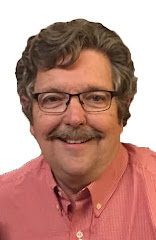Cousins inspire after death
By Mike Haynes
If it were
just my family, I wouldn’t be so quick to write about Joyce and Vester. But
those cousins who died a day apart Dec. 20 and Dec. 21 were known in their
communities and far beyond, and their absence leaves noticeable holes in the
fabric of McLean and Higgins.
They said
they were each other’s favorite cousins. Joyce, my mother, was the daughter of
Ruel Smith, and Vester was the son of Ruel’s brother, the elder Vester. Vester,
91, and Joyce, 83, both took pride in their Smith heritage as well as that of
their spouses – the family of Johnny Haynes for Joyce and that of Martha Price Smith
for Vester.
 |
| Vester Smith and Joyce Haynes hold their hands to their hearts at the state basketball tournament in Austin in 2010. |
The two
memorial services weren’t the kind where the preacher has to interview the relatives
to find something to say. Vester and Joyce spent much time in their respective
Methodist churches. Vester’s friend and former pastor Don Travis knew details
of the rancher’s life such as the thousands of eggs Vester had cooked for the
Higgins men’s group. Joyce’s nephew and pastor Thacker Haynes had heard plenty
of chords from her years as the church organist and had enjoyed lots of her
chocolate pie.
 |
| Glenda Joyce Haynes |
The two
cousins’ families wore their tires down on the roads between Higgins and Canadian
and between McLean and Amarillo. For weeks, neither hospital room was devoid of
a spouse, son or daughter for more than a night. My dad got to know many of the
Northwest Texas Healthcare nurses and technicians, as did the rest of our
family. I know Dad misses some of those kindhearted caregivers.
Mom’s Amarillo
surgeon kept our family updated on the increasingly slim prospects for recovery
despite her fighting spirit. We noticed that his face sometimes showed more
emotion than you would expect from a doctor. He told Dad he had observed how our
family was dealing with the tough situation.
 |
| Vester Lee Smith |
Members of
each family attended the two funerals. On a frigid, snowy day in Higgins, we
witnessed a community that filled the sanctuary and the church basement. The
impact of Vester, friend to all, a storyteller and a John Wayne with more
finesse, was obvious.
On a sunny
day in McLean, the same sort of tribute arrived in the form of friends and
family from near and far. This side of heaven, my mother didn’t know the effect
she had on people she hardly knew. My family had been at the hospital every day
out of duty and love, just because that’s what you do when Mom’s sick.
At the
memorial service, we saw a familiar face standing at the back of the church,
not in medical scrubs but in suit and tie. It was her surgeon. He had noticed
something about our constant presence that made him drive the 70 miles to McLean
the day after Christmas. Mom barely knew this doctor who had operated on her.
We knew him only from the ICU. But he sensed something in Dad and in what Mom
and Dad had passed on to their children and grandchildren.
I saw the
same thing in Vester’s family. My second and third cousins came from Oklahoma,
Austin and elsewhere to just be there through sickness and past death.
Since Mom’s
funeral, friends have told me her service reminded them of good times with her
but also stirred memories of McLean during the past several decades. I’m sure
Vester’s friends in Higgins and across West Texas are saying similar things.
As heartbreaking
as the losses are, the passing of two people has inspired others. May we all be
as important to our communities, as active and willing to work and as faithful
to God as Vester and Joyce were.




